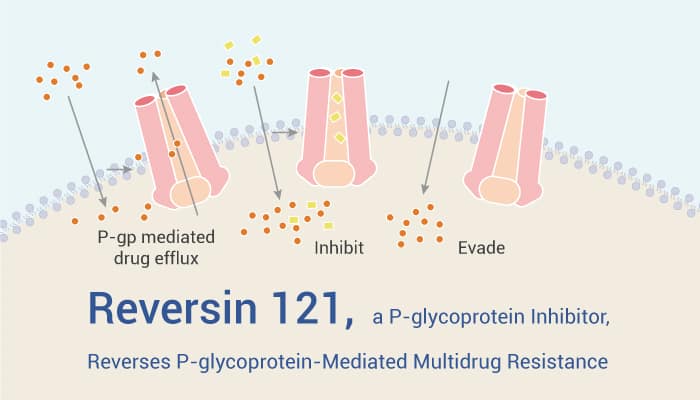Nowadays, how to overcome the resistance of tumor cells to multiple drugs is still a serious problem. Various mechanisms can cause Multidrug resistance (MDR), including cell cycle alterations, increased repair of damaged DNA and activation of detoxifying systems. Noticeably, ATP-binding cassette proteins are the most significant factor in drug resistance. As an ATP-dependent efflux pump, P-glycoprotein (P-gp) is expressed on large amounts of cancer cells. For example, pancreatic cancer and lung cancer cells both expresses P-gp . Therefore, P-gp is one of the major contributors to MDR. Specifically, it protects MDR cancer cells by effluxing cytotoxic drugs. P-gp is also an important cell membrane protein that pumps many foreign substances out of cells.
Reversin 121, a P-glycoprotein inhibitor, reverses P-glycoprotein-mediated multidrug resistance in cancer.

Reversin 121, a hydrophobic peptide chemosensitizer, is a P-glycoprotein inhibitor. It also increases the ATPase activity of MDR1. Importantly, Reversin 121 reverses P-glycoprotein-mediated multidrug resistance with little toxic side effects.
In vitro, Reversin 121 (5 μM, 96 h) reverses the resistance against paclitaxel in paclitaxel-resistant cells (NCI-H460 and PTX250 cell. Reversin 121 (12 μg/mL), together with Gemcitabine, also reduce the proportions of MDR-positive tumor cells in Panc1 cells. Besides, Reversin 121 (10 μM, 48 h) inhibits T cell proliferation during DC-T cell interactions. As for in vivo, Reversin 121 (2.5 mg/kg, plus 5-fluorouracil of 35 mg/kg/day, i.p., 5 days a week) decreases tumor size and prevalence of metastases in orthotopic pancreatic carcinoma mouse model. In this model, Reversin 121 decreases more MRP3-positive cells in pancreases compared to 5-fluorouracil monotherapy, which is determined by flow cytometry.
In conclusion, Reversin 121 is a potent P-glycoprotein inhibitor. More imoratntly, it reverses P-glycoprotein-mediated multidrug resistance. It can combine with chemotherapeutic agent and show high anticancer efficiency.
References:
[1] Hoffmann K, et al. Tumour Biol. 2008;29(6):351-8.
[2] Yabuki N, et al. Cancer Genet Cytogenet. 2007 Feb;173(1):1-9.